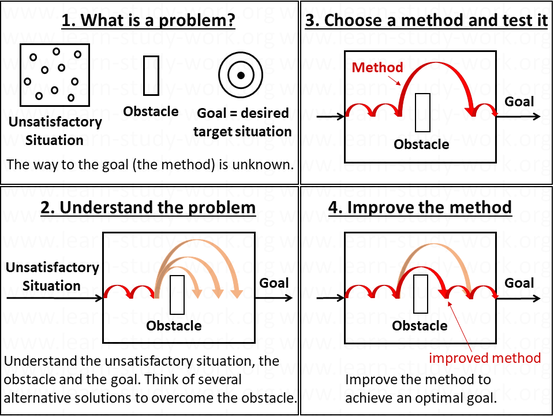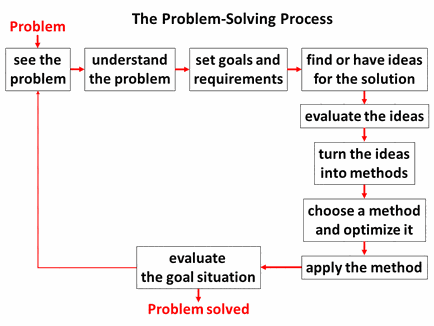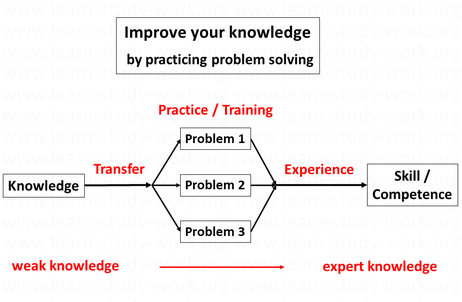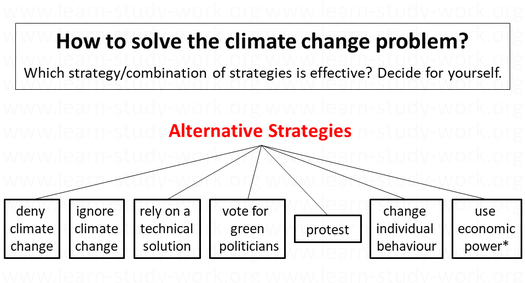How to solve difficult problems
Key message: To solve difficult problems, we need expertise, general knowledge and problem-solving skills. Creative problem-solving requires methodical and disciplined efforts.
What is a problem?

I have a problem when I am dissatisfied with a current situation, but at the moment I am not able to achieve the desired target situation (the goal). It may be that I do not know what the goal looks like or the means to achieve the goal are unknown or an obstacle must be overcome on the way to the goal (e.g. the required means may be known but not available). So a problem solution has four main elements: the initial situation, the obstacle, the goal and the method to achieve the goal.
"A
problem occurs when a problem solver has a goal but initially does not know how to achieve the goal. This definition has three parts: (1) the current state - the problems begins
in a given state; (2) the goal state - the problem solver wants the problem to be in a different state, and problem solving is required to transform the problem from the current (or
given) state into the goal state, and (3) obstacles - the problem solver does not know the correct solution and an effective solution method is not obvious to the problem solver."
(https://education.stateuniversity.com/pages/2168/Learning-PROBLEM-SOLVING.html,
24.01.20)
In order to solve a problem, three main steps must always be carried out:
-
analyze the problem
-
generate several alternative solutions (find existing ideas or create new ones)
- make a decision.
(Lindemann, U. (2009). Methodische Entwicklung technischer Produkte. Heidelberg: Springer, p. 46)
What are difficult problems?
"Modern life faces humans with many varieties of complex, non-linear and multi-causal phenomena, across economic systems, politics, business, organizations, technical, and ecological systems. ...
In complex dynamic systems there can be no simple attribution of causes to effects. Such systems frequently display non-linear behavior, i.e., patterns that are neither stable nor cyclic, but
buffered, delayed, amplified, 'out of place', or that display leaps and fluctuations." (Kimmel, M. (2023). Inviting systemic self-organization: Competencies for complexity
regulation from a post-cognitivist perspective. Journal of Dynamic Decision Making, 9, p. 1-2)
In simple terms: Problems are difficult to solve if a lot of information about the problem is missing and the missing information can only be obtained with great effort or not at all. In such a case, a problem solver must use his creativity.
"Dörner (1975) characterized complex problems as involving dynamic systems that people must deal with under conditions of uncertainty. These systems can be described by their (1) complexity (number of interconnected elements; requires complexity reduction), (2) interconnectedness (relations between the elements; requires model building), (3) intransparency (availability and accessibility to relevant information; requires information retrieval and information management), (4) dynamics (system changes over time – either slow or fast; requires prediction of future developments), and (5) whether they involve competing goals (polytelic goal structure; requires balancing of competing interests)." (Funke, J., Fischer, A., & Holt, D. V. (2018). Competencies for complexity: Problem solving in the twenty-first century. Assessment and teaching of 21st century skills: Research and applications, p. 4)
The problem-solving process
"A common misconception regarding the CPS [creative problem-solving] process is that it is a freewheeling, unstructured, almost mystical process. This belief is fostered by anecdotes of creative breakthroughs occurring during periods of unconscious sleep or via some subconscious thought process. Although entirely possible, research on creativity has found the CPS process to require much more methodical, disciplined, and sustained cognitive effort ...
... the CPS process involves some degree of problem preparation followed by periods of idea generation, idea evaluation and refinement, and idea implementation. During problem preparation, the
problem is identified, relevant information gathered, and the problem further delineated, producing a clear
problem definition. Problem preparation is then followed by a period of "solution finding" where activities are undertaken to generate, to evaluate, and to refine new ideas that ultimately lead
to a creative solution(s) to the problem. Finally, the solution is administered or implemented to actually resolve the problem." (Titus, P. A. (2000). Marketing and the creative problem-solving
process. Journal of Marketing Education, 22, p. 226)
The following figure shows my understanding of the problem-solving process:

We go through this process quite quickly when we want to solve small problems: We want to achieve a goal, but we don't know how. We recognize this as a problem and try to understand it. We estimate how much time we have to reach the goal and determine how optimal our problem solution should be. Based on our existing knowledge, we develop ideas to solve the problem. We consider how these ideas could be implemented. Then we select the best idea and optimize the method by which it can be implemented. We apply the method and check whether we have achieved our goal with the desired quality.
With major problems, every step in the process is difficult. Read the explanation for every step of the problem-solving process on Learn-Study-Work:
- see/recognize the problem
- understand the problem (analyze situations = systems)
- set goals and requirements
- find or have new ideas for the solution (become creative)
- evaluate the ideas
- turn the ideas into methods
- choose a method and optimize it (not ready yet)
- apply the method (not ready yet)
- evaluate the goal situation (not ready yet)
Many problems are very difficult or impossible to solve because they were not recognized in time.
"The ability to detect problems at early stages can lead to more timely and effective interventions. Conversely, failures of early problem detection can result in accidents and performance breakdowns if action is not initiated until the situation has deteriorated to the point where recovery is impossible." (Klein, G., Pliske, R. Crandall, B., & Woods, D. D. (2005). Problem detection. Cognition, Technology & Work 7(1), p. 14)
Recognizing problems is also a chance to set and achieve new goals.
"In artificial cognitive systems, goals serve functions similar to those they do in people. ... Autonomy involves not only the capacity to achieve given goals, but it also concerns the ability to recognize new problems and to propose goals that are worth achieving. ... Both opportunities and threats in the world require an agent to anticipate events within the context of its interests." (Cox, M. T. (2013). Goal-Driven Autonomy and Question-Based Problem Recognition. In Poster Collection. Palo Alto, CA: Cognitive Systems Foundation. http://mcox.org, 29.08.21, p. 2)
There are two ways to solve a complex problem: A problem can be solved in a single pass of the problem-solving process or the problem is divided into sub-problems and these are solved one after the other.
What knowledge and skills do we need to solve problems?
"... we defend the position that the ... assertion (ie that the central focus of education should be to inculcate general skills like critical thinking, problem solving, clinical reasoning and reflection) is indeed a myth. ... the evidence demonstrates again and again that the essence of expertise is the possession of a large, organised and retrievable body of both formal and experiential knowledge, not any kind of general thinking skills." (Monteiro S, Sherbino J, Sibbald M, Norman G. Critical thinking, biases and dual processing: The enduring myth of generalisable skills. Med Educ. 2020;54(1), p. 66)
"Consider ... the myth examined by Monteiro et al [see the quote above] in this issue of Medical Education. ... The authors call into question the utility of dedicating valuable teaching time to content‐independent general cognitive skills when the impact of this type of education on improving rates of diagnostic error remains unclear." (Dehmoobad Sharifabadi A, Clarkin C, Doja A. Myths in medicine: How did we get here? Med Educ. 2020 Jan;54(1), p. 13)
No one claims that the central focus of an education should be to teach general skills, but one must be able to apply knowledge. The ability to apply knowledge is called skill or competence (in my opinion skill and competence are the same).
"... ‘competence’ means the proven ability to use knowledge, skills and personal, social and/or methodological abilities ..." (https://eur-lex.europa.eu/legal-content/EN/TXT/HTML/?uri=CELEX:32017H0615(01)&from=DE#d1e32-20-1, 14.11.20, annex 1)
"Personal, social, and methodological abilities" are general skills that help apply knowledge. Understanding the problem-solving process is a "methodological ability".
"Methodological competence [refers to the] willingness and ability to proceed in a goal-oriented, systematic approach when dealing with tasks and problems (for example, when planning the work steps)." (www.kmk.org/fileadmin/veroeffentlichungen_beschluesse/2021/2021_06_17-GEP-Handreichung.pdf, 07.11.21, p. 16)
Each step of the
problem solving process requires a great deal of knowledge related to the problem at hand. It is important to recognize what knowledge is missing to solve the problem. People who have no
experience in problem solving often make mistakes here. In my experience, people with problem-solving skills put more effort into gathering the necessary knowledge because they want to find an
optimal solution and because they take into account that something can go wrong.
How can an expert come into the "possession of a large, organised and retrievable body of both formal and experiential knowledge" (the request of the above articles)?
"Understanding is about transfer ... To be truly able requires the ability to transfer what we have learned to new and sometimes confusing settings. The ability to transfer our knowledge and skill effectively involves the capacity to take what we know and use it creatively, flexibly, fluently, in different settings or problems, on our own. Transferability is not mere plugging in of previously learned knowledge and skill." (Wiggins, G., & McTighe, J. (1998). Understanding by design. Alexandria, VA: ASCD, p. 40)
A deep understanding of knowledge can only be achieved by applying it and thus gaining experience.
"We develop expertise through years of experience, but years of experience do not guarantee an individual will become an expert. ... As expertise develops, knowledge transitions from being a collection of isolated facts to a heavily integrated network of information and decision-making process, conditional on a set of circumstances. ... Experts solve problems by forming mental representations of the problem, which are used to infer relationships that define the situation and its constraints. Defining the situation and its constraints leads to a clear picture of the problem and identification of a clear solution." (Persky, A. M., & Robinson, J. D. (2017). Moving from novice to expertise and its implications for instruction. American journal of pharmaceutical education, 81(9), 6065, https://www.ncbi.nlm.nih.gov/pmc/articles/PMC5738945/?trk=public_post_comment-text)

If our knowledge is not complete, i.e. if necessary information is missing, then our creativity is required.
"Expertise encompasses everything that a person knows and can do in the broad domain of his or her work. ... Creative thinking ... refers to how people approach problems and solutions - their capacity to put existing ideas together in new combinations. ... Expertise and creative thinking are an individual's raw materials - his or her natural resources, if you will. But a third factor - motivation - determines what people will actually do." (Amabile, T. M. (1998). ‘How to kill creativity’. Harvard Business Review, Sept/Oct, p. 78,79)
Creativity is the ability to come up with new ideas that are useful based on incomplete information (Read on Learn-Study-Work: "How to be creative", "How to motivate someone").
"The expert's motivation focuses on mastery which is associated with persistence toward a goal. Experts continually focus their effort toward improving their knowledge base and skillset to achieve and maintain their expertise. They must constantly practice, be open to challenging new experiences and engage in self- reflective processes." (Persky, A. M., & Robinson, J. D. (2017). Moving from novice to expertise and its implications for instruction. American journal of pharmaceutical education, 81(9), 6065.)
Why are communication and collaboration important for solving difficult problems?
"Many complex problems in the real world are not tackled by individuals but by people collaborating in teams. Collaboration brings certain benefits, e.g., sharing knowledge, combining specialist skills, or distributing work, but also introduces difficulties through miscommunication, coordination losses, and potential goal conflicts." (Funke, J., Fischer, A., & Holt, D. V. (2018). Competencies for complexity: Problem solving in the twenty-first century. Assessment and teaching of 21st century skills: Research and applications, p. 49)
"Levy and Murnane (2003) and Deming (2015) further found that the skills for which there was the greatest increase in demand in the last decades of the 20 th century were non-routine analytical skills (i.e. those involved in problem solving) and, to an even larger extent, non-cognitive (or social) skills, including collaboration skills." (https://read.oecd-ilibrary.org/education/pisa-2015-results-volume-v/what-is-collaborative-problem-solving_9789264285521-7-en#page1, 22.06.24, p.46)
How to solve the climate change problem?
Learn-Study-Work is not a political website. Therefore this is just an example how to apply the first steps of the problems solving process.
First step: See the problem
At first people did
not notice that industrialization is causing climate change. Then they realized that climate change can be threatening to the earth.
Second step: Understand the problem
People studied climate change and understood that climate change is an "unsatisfactory situation" because as a result glaciers and sea ice melt, the sea level rises, more flooding and droughts occur, hurricanes and other storms become stronger, species become extinct and some diseases can spread due to migration.
Third step: Set the goal
A possible goal is to stop the climate change by reducing the amount of carbon dioxide and other greenhouse gases in the atmosphere.
Unfortunately this is not easy to do because there are two obstacles:
1. To stop the climate change, many people would have to change their lifestyles considerably but not enough people agree.
2. To stop the climate change without changing the lifestyle would cost a huge amount of money but not enough countries are able or agree to invest this amount of money.
Fourth step: Find or have ideas to solve the problem
After understanding the situation, the obstacles and the goal it is necessary to think about possible solutions how to overcome the obstacles and to achieve the goal. Here is a list of possible strategies (a strategie is a long-term plan):

*) "Use economic power" means buying green products and services and investing in "green" business.
Everyone must decide for himself which of these alternative strategies is effective and is in line with his values. Probably only a combination of different strategies will lead to solving the problem of climate change. Maybe you are creative and find further strategies.
Read on Learn-Study-Work:
"How to define words", "What is Respect", "How to respond to disrespect", "What is Science", "What is Health", "How to write a text", "How to analyze situations = systems", "How to be creative", "How to recognize problems"
